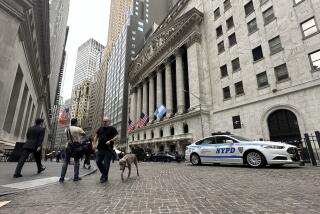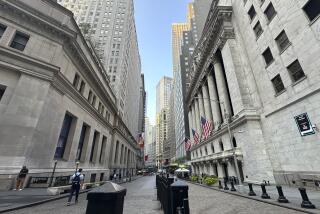New Growth Seen as Key Index Rises : Stock Market Fuels Indicators’ Biggest Jump in 2 1/2 Years
WASHINGTON — The government’s main forecasting barometer of future economic activity jumped 1.5% in April, the largest such increase in 2 1/2 years, the Commerce Department reported Thursday, raising still further the Administration’s expectations for strong growth later this year.
The strong rise in the index of leading indicators, up a solid 0.9% in March and up 1.4% during the first three months of the year, was led by its financial components, especially a booming stock market and a surging money supply. The April increase was the largest gain in the index since an identical 1.5% rise in October, 1983, and a 1.9% gain in June, 1983.
“The report is every bit as good as it looks if the financial markets can stay as strong as they are,” said Roger Brinner of Data Resources Inc. “And I think they are real because the pr1869836389Congress should take a lot of the fear out of the markets.”
A Quickening Economy
Other economists pointed out that other components--such as new orders for consumer goods, increased consumer and business borrowing, declining unemployment claims and increasing applications for building permits--suggested a quickening pace throughout the economy.
For that reason, the upbeat report is even better than it looks, said Irwin Kellner, chief economist at Manufacturers Hanover. “It was broadly based. If you were to take out the money supply, the index would still have gone up 1%. It’s not just financial, because the544367969said.
Even if the monthly increase were interpreted as primarily a phenomenon of booming financial markets, there would be nothing to worry about, said Allen Sinai, chief economist at Shearson Lehman Bros.
‘The Leading Edge’
“Continued driving by the financial markets is not a sign of weakness because they are historically the leading edge of the leading indicators,” he said. “You have always had market strength out front, so it’s consistent with history.”
But Sinai said that the increases were not simply a matter of markets and money supply, pointing to the resurgent strength in new orders for consumer goods, new business formations and consumer and business credit--all up 0.2%. “This was a robust, wide, broad-based rise,” he said, “a clear indication of better times ahead. The U.S. economy seems to be emerging into the higher growth phase Administration policy-makers wanted.”
The Administration has steadfastly been forecasting 4% growth for all of 1986, and a recently revised estimate of economic growth in the January-March quarter put it at 3.7%, not far off the mark. Most economists see a weaker current quarter, with resurgent growth in the second half of the year.
The 11 reported components in the index included three slight declines: in the average workweek, in orders for capital goods and in prices for basic materials--all down 0.1%. Vendor performance was unchanged.
But the workweek decline in part reflected a substantial 3.6% increase in business productivity so far this year, according to a Labor Department report for the first quarter. And the decline in materials prices, a consistent factor in recent months, reflects the drop in oil prices and worldwide deflation in basic commodities.
Capital Goods Sluggish
However, Commerce Secretary Malcolm Baldrige expressed cautious concern about the sluggish demand for business equipment and capital goods generally. “The leading indicators continue to suggest a healthy economic climate ahead,” he said, “although I would like to see more zip in new orders.”
“Because of inventory adjustments in the automobile industry, growth may ease in the second quarter,” Baldrige added. “But, with lower interest rates, lower inflation and a more competitive dollar, the economy’s pace should accelerate during the second half.”
Brinner, whose Lexington, Mass., economic forecasting firm has tended to look coldly on Administration optimism, said he now sees 3% growth for all of 1986.
No Need to Expand Plants
And he dismissed the relative slump in capital goods orders as “only logical: We are stuck at an 80% capacity utilization rate, so there is no need for plant expansion. In the tax bill, manufacturers are facing the loss of accelerated depreciation and of the investment tax credit.”
However, he said: “The bad numbers are mixed with good. The consumer numbers are pretty good, and it’s reasonable to believe that they will remain strong.”
More to Read
Inside the business of entertainment
The Wide Shot brings you news, analysis and insights on everything from streaming wars to production — and what it all means for the future.
You may occasionally receive promotional content from the Los Angeles Times.










